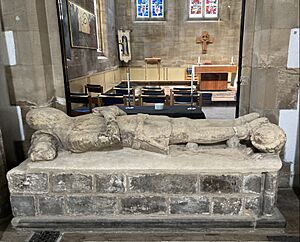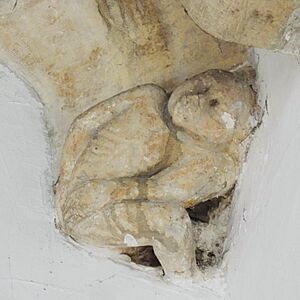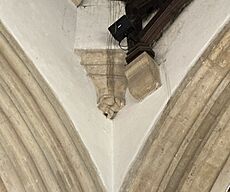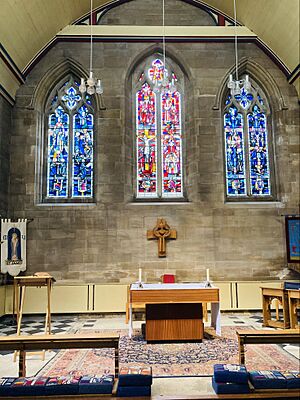Grimsby Minster facts for kids
Quick facts for kids Grimsby Minster |
|
|---|---|
| The Minster and Parish Church of St James, Grimsby |
|
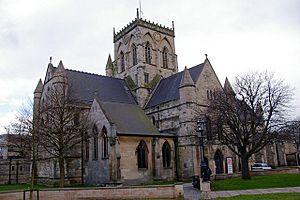 |
|
| 53°33′50″N 0°05′22″W / 53.563792°N 0.089360°W | |
| OS grid reference | TA 26640 09169 |
| Location | Grimsby, North East Lincolnshire |
| Country | England |
| Denomination | Church of England |
| Churchmanship | Central |
| Website | grimsbyminster.com |
| History | |
| Former name(s) | Grimsby Parish Church; St James' Church; The Church of St Mary and St James |
| Status | Parish church |
| Dedication | James, son of Zebedee |
| Past bishop(s) | Rt Rev David Tustin, Rt Rev David Rossdale |
| Architecture | |
| Functional status | Active |
| Heritage designation | Grade I listed building |
| Administration | |
| Parish | Grimsby |
| Deanery | Grimsby |
| Archdeaconry | Stow & Lindsey |
| Diocese | Lincoln |
| Province | Canterbury |
Grimsby Minster is a very old and important church in Grimsby, England. It is also known as the Parish Church of St James. This church is part of the Church of England. It is dedicated to St James.
Contents
The Minster's History
In 1114, a religious building was given to Robert Bloet. He was the Bishop of Lincoln. Over the next years, he made many changes to the building. This led to the creation of St James Church. It had a large main area called a nave.
A tall central tower was added in 1365. In 1586, St James became the main church for Grimsby. This happened after John Whitgift joined the churches of St James and St Mary's.
In 1856, Canon Ainslie started a big restoration project. This included making the chancel longer. The chancel is the part of the church near the altar. They also rebuilt the south transept. Later, new windows with stone designs were put in. New oak roofs were also added.
St James' School Connection
An important event was the opening of James College in 1883. This school was started by Canon Young. It was the only choir school in the UK connected to a parish church. This changed in September 2013. The choir was reorganized by Anthony Pinel. Now, boys and girls from any local school can join the choir.
Becoming a Minster
The church was given special "minster" status in 2010. This news was announced in the Grimsby Telegraph. The special ceremony happened on May 16, 2010. The Lord Bishop of Lincoln led the event. The Mayor of North East Lincolnshire accepted the official declaration.
How the Parish Works
The Parish of Grimsby includes Grimsby Minster. It also includes St Hugh's Church. St Hugh's was built as a 'daughter church' of St James. These two churches share one church council.
Until August 31, 2022, the parish also had St Martin's and St Mark's churches. On September 1, 2022, these two churches formed their own new parish.
Grim's Tomb Legend
In 1913, a church worker mistakenly called a memorial 'Grim's Tomb'. For many years, people in Grimsby believed that Grim was buried here. Grim was a Viking founder of the town. He was probably a mythical figure.
A famous legend tells of Havelok. He was a Danish prince who came to rule part of England. This story was first written down in the 13th century. It is a lively poem about what makes a good ruler. It shows that kindness is rewarded and cruelty is punished.
The stone figure on the tomb is actually Sir Thomas Haslerton. He was a knight from the 14th century. His family owned land near the Humber River. Sir Thomas was known for his generosity. He rebuilt St Leonard's Nunnery after it was destroyed by fire. This nunnery was located where Bargate and Weelsby Road meet today. That area is still called Nun's Corner.
Beautiful Windows
The stained-glass windows in the Minster are very famous. They are well-known in the Diocese of Lincoln. The windows on the south side show the history of the Anglican Church. The windows on the north side show the life of Jesus. They show scenes from the Adoration of the Magi to the Last Supper.
These windows were put in around 1910. The names of the people who donated them are on brass plaques. Most of the original windows were destroyed by bombs in 1943. This happened during the Second World War. They were replaced with new ones that looked like the old designs. Many generous people helped pay for them after the war.
The Grimsby Imp
In the south aisle, high up on a column, is a stone carving. It is from the 12th century and is called the Grimsby Imp. A legend connects this imp to the Lincoln Imp. The story says both were sent by the devil. They were meant to cause trouble at Lincoln Cathedral. They broke things and tripped people.
God sent an angel to warn them to stop. One imp was scared and hid. The other imp threw rocks at the angel. It was immediately turned to stone as the Lincoln Imp.
The other imp promised to be good. It ran away to Grimsby. But it soon started causing trouble again. The angel followed it and turned it to stone too.
Some people don't believe it's an imp. They think it's a carving of a man. He looks like he is holding up the church beams. In May 2021, an article in Grimsby Live talked about the imp. It mentioned the twisted spire of Chesterfield Parish Church. A vicar at Grimsby Minster had a different idea. He thought a craftsman who built the Minster carved the figure. It was just a man bending over to support the church.
In September 2021, the Lincoln Imp Trail included Grimsby Minster. This trail featured 32 painted sculptures. They were inspired by the Lincoln Imp. The sculptures were placed around Lincolnshire.
Lady Chapel
The Lady Chapel is where a medieval chapel once stood. That old chapel was taken down around 1720. The current Lady Chapel opened in 1905. It was built to remember Canon James Peter Young. He was a Vicar of Grimsby in the 1800s. He also founded schools.
The chapel has a special medieval window called a Hagioscope. This window gave a good view of the High Altar during Mass. The chapel is dedicated to 'Our Lady'. This honors the Blessed Virgin Mary, who was the mother of Jesus.
Memorial Chapel

The Memorial Chapel was finished in 1921. Canon Algernon Markham helped make it happen. A Roll of Honour is inside the chapel. It lists 2,100 local people. They gave their lives during the First World War. Their names are written on gunmetal. Sir Alec Black generously paid for this.
There is also a memorial to the "Grimsby Chums". This was a special group of soldiers. They joined the Royal Lincolnshire Regiment in 1914. They joined together with their friends, or "pals." There were 304 such 'Pals Battalions'. But only the one from Grimsby chose to be called the "Chums."
Church Organs
The church has two large pipe organs. The organ at the west end was built in 1951. It replaced an older organ that was destroyed in the Second World War. Some parts of the old organ were used in the new one. You can find details and pictures of this organ online.
Because the west end is far from the choir, a second organ was added. This happened in the 1970s. It is on the north side of the choir. This organ is used to accompany the choir during services.
Past Organists
Many talented people have been organists here. Some of them include:
- Edwin Brammer (around 1872)
- James Forbes Carter (around 1896)
- John Stanley Robson (1924 – 1953)
- Eric Arthur Conningsby (1954 – 1955)
- Dennis Townhill (1956 – 1961)
- Martin How (1961 – 1964)
- Michael Dudman (1964 – 1968)
- Robert Walker (1968 – 1973)
- Christopher Weaver (1974 – 1979)
- Andrew Brade (1979 – 1981)
- Patrick Larley (1982 – 1987)
- Andrew Shaw (1987 – 1993)
- Andrew Cantrill (1994 – 1996)
- Steven Maxson (1997 – 2003)
- Adrian Roberts (2003 – 2006)
- Anthony Pinel (2006 – 2014)
- Steven Maxson (2014 – 2021)
Assistant Organists
- E. Charles Hopkins (1956 – around 1958)
- Philip Cave (1968–1971)
- Anthony Marwood (1971-)
- Andrew Brade (1977 – 1979)
- Stephen Maltby (1979 – 1982)
- Barry Whitfield (1991 – 2006)
- Steven Maxson (2006 – 2014)
- Stefano Golli (2014)
The Minster Choir
Grimsby Minster was once the only parish church in England with its own choir school. This was St James' School. Canon James Peter Young started the school in 1880. It was for educating choirboys. Today, it is a school for both boys and girls.
Since September 2013, the choir has changed. Boys are now chosen from all over North East Lincolnshire. Girls can also join the choir.
Church Bells
The Minster has 10 bells. They are used for full-circle ringing. All the bells together weigh about 4.3 tonnes. The largest bell, called the tenor, weighs about 18.25 cwt. It is 4 feet wide. The bells are tuned to the key of E flat.
The bells were made starting in 1830. Three were cast by William Dobson. Other bellmakers have made the rest since then. These include John Taylor & Co and John Warner & Sons. The newest bells were made in 1962. They were cast by Mears and Stainbank.
Church Grounds and Art
The old churchyard is now called 'St James Square'. It was redeveloped in 2021. This project cost £1.8 million. The square has three permanent artworks:
- The 'Fishermen's Memorial' is a bronze statue. It shows a fisherman pulling in a net. Sculptor Trevor Harries created it. It was put in the square in 2005.
- 'Human Murmuration' is on a wall on the east side of the square. It shows silhouettes of local people. They volunteered to be photographed for the artwork. Annabel McCourt created it.
- 'Come Follow Me' is a long text artwork. It is etched into the stone paving of the square. It is 35 meters long. It features poetry by local writers. Adrian Riley created this artwork.
See also
 In Spanish: Grimsby Minster para niños
In Spanish: Grimsby Minster para niños


